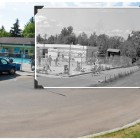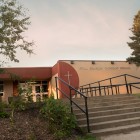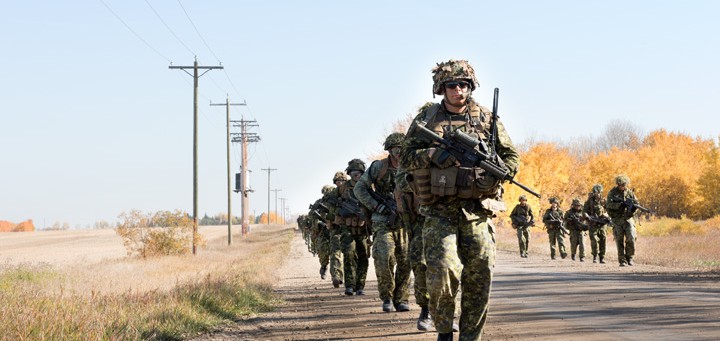
Then & Now
WARTIME ST. ALBERT
December, 2015
While 100 years separate the people of St. Albert from the First World War, the marks of it and other major conflicts remain. And though an article cannot capture the brutality of war or the struggles for families whose lives were forever altered, it is with deep gratitude that we prepare for Remembrance Day. To the courageous men and women of St. Albert who fought, and to their families and friends who supported them on return––we remember you. Here is a look back at wartime St. Albert.
The First World War
On August 4, 1914, Britain declared war on Germany, and the First World War began.
While records differ, at least 60 men and 1 woman from the St. Albert area enlisted and took the fight to Europe. St. Albert’s population of just over 1,000 was largely fracophone at the time, with many citizens from hometowns in France and Belgium.
In 1915, reports of fatalities of our local soldiers started coming in. Many were wounded, and others were exposed to mustard gas. Records show that at least 10 soldiers from our community were killed in action.
Gerard Brutinel, a local businessman, initiated the 1st Canadian Motor Machine Gun Brigade using significant personal investment and capital acquired from his business contacts across Canada. His political influence helped him navigate the complex steps that allowed the project to proceed. The mobile brigade used, what was then, an innovative approach to deliver indirect fire to great effect in battle. Reports from 1918 supported the effectiveness of the 476 mobile Vickers machine guns and the new tactics.
On September 5, 1916, St. Albert Council passed a resolution to request the city of Winnipeg to prevail on the federal government to provide equal valued pensions for all soldiers, regardless of rank.
About the same time, prohibition became law. Its original intention was to support the war effort with abstinence. Prohibition ended in 1924.
On August 29, 1917, the Canadian federal government introduced conscription.
In 1918, hostilities on the Western Front stopped, and enlisted men made their way home to find the community struggling with the Spanish flu epidemic and jobs in short supply.
The Second World War
Canada declared war on Germany on September 10, 1939.
Between the years of 1939 and 1945, close to 160 residents from St. Albert signed up with the Canadian Armed Forces. At least eight were killed in action.
War years were lean in St. Albert, as in the rest of Canada. Rationing of grocery items (such as butter and meat) helped Canada deal with the shortage of these products but created challenges for families.
In April of 1942, after hasty approval to proceed, the United States began urgent -construction of the Alaska Highway, providing needed employment for locals.
After the war ended, the community and families welcomed home our soldiers, celebrating victory and mourning losses.
The Korean War
In the mid 1940s, the original Legal schoolhThe years between 1950 and 1953 saw nearly 27,000 Canadian troops involved, with 516 killed in the conflict.
We found no records of any St. Albert residents participating in the Korean War.
Now
The 3rd Canadian Division Support Base, commonly known as Edmonton Garrison, is home of the command of army operations from the Pacific to Thunder Bay.
There are currently 6,000 regular-force soldiers, 5,700 reserve-force soldiers and 1,200 civilians under the command of the 3rd Canadian Division.
Today, St. Albert is home to many military and support personnel, continuing our rich military history.
The 1 Canadian Mechanized Brigade Group (1CMBG) resides at Edmonton Garrison and consists of the following units: 1st Regiment, Royal Canadian Horse Artillery; 1st Battalion, Princess Patricia’s Canadian Light Infantry; 2nd Battalion, Princess Patricia’s Canadian Light Infantry; 3rd Battalion, Princess Patricia’s Canadian Light Infantry; 1 Combat Engineer Regiment; 1 Service Battalion; 1 Canadian Mechanized Brigade Group Headquarters & Signal Squadron. t8n
St. Albert Remembers
In 2014, the Musée Héritage featured two WWI commemorations: Joining Up and The Home Front. Joining Up featured a long list of St. Albert residents. Their short biographies show an overwhelming number of young men between the ages of 18 and 25. Names like Atkinson, Chevingy, Gagnon, Kennedy, Savoie, Savard and Scragg make up that list.
Did You Know?
Charlotte Cameron wrote a one-act play about the Cree hero and running warrior, Alex Decoteau. The play was first produced in 2001 at the Edmonton International Fringe Theatre Festival. Decoteau was Canada’s first aboriginal police officer. He raced for Canada at the 1912 Olympics in Stockholm and fought for Canada in the First World War. Decoteau was killed in 1917 running a message at the Battle of Passchendaele. He was only 29 years old.
Caption:
Main photo: 3rd Battalion, Princess Patricia’s Canadian Light Infantry conducting a readiness-training road march from Edmonton Garrison to Villeneuve Airport.
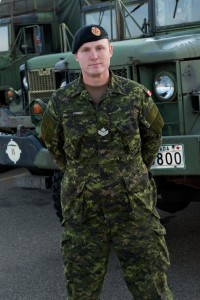
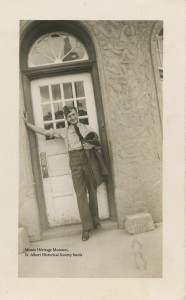
Image credit: Musée Héritage Museum, St Albert Historical Society fonds 2003.01.1458






